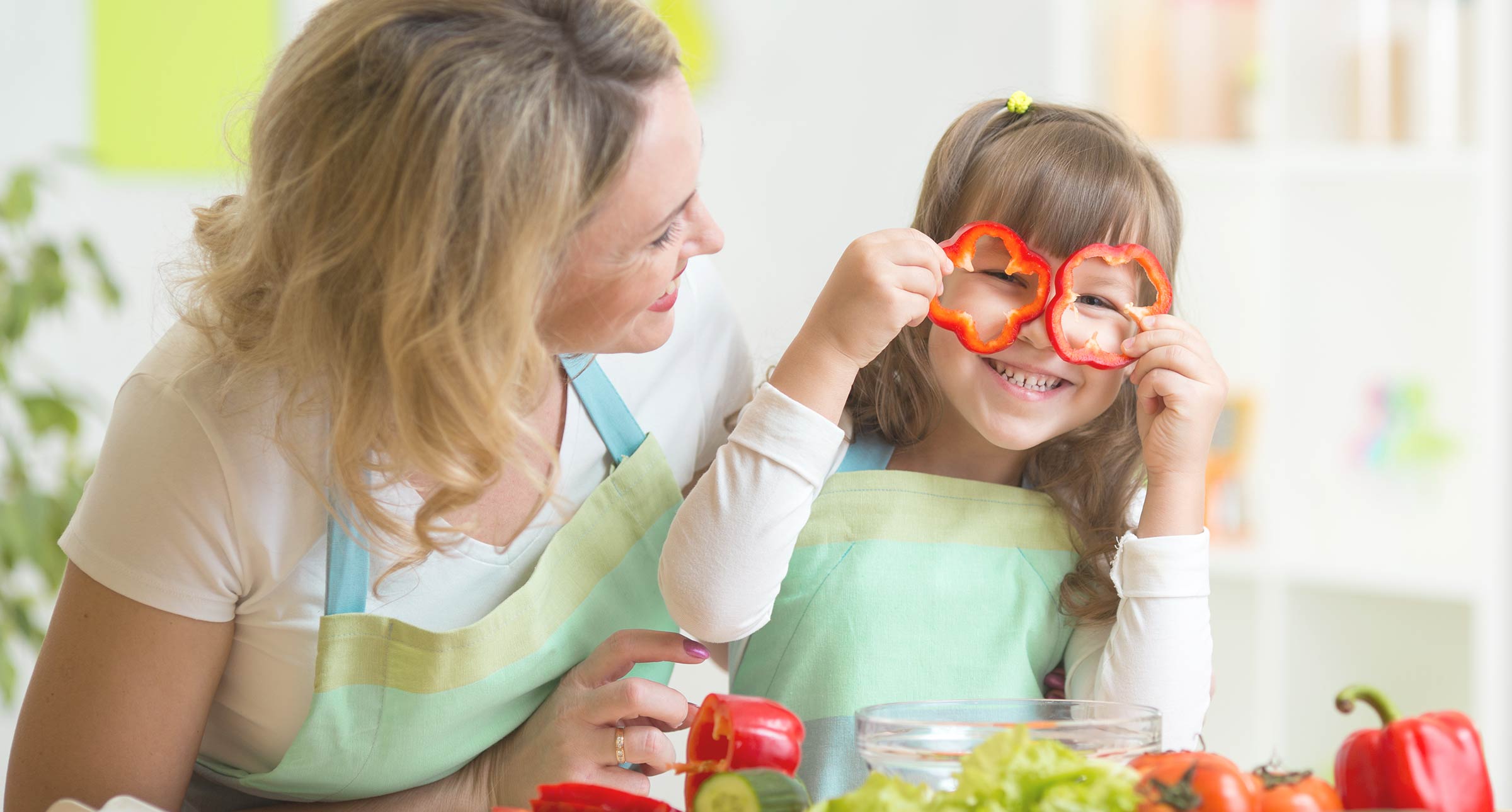The sad truth is, we all feel bad about our bodies, at least a little bit. Western societies put an incredible amount of pressure on our appearance using an unreasonable number of benchmarks. For certain groups, such as women, there is even more pressure put on our appearance. In the 1980s, body image difficulties were so widespread that a theorist named Rodin called this “normalized discontent.” This pressure is so broad, insidious, and persistent, it’s all too easy to miss some of its subtler effects, especially when it comes to talking to our children about food.
As a mother myself, I know that many parents want a future for their kids that is better than their own, one that includes a healthy relationship with food and body image. But how do we get our kids there, especially if maybe we are still learning ourselves?
Learning and Unlearning
As a woman living in a Western society, a psychologist-in-training, and as a researcher of body image difficulties, I have learned and unlearned a lot about what can make people feel poorly about their body. From clients struggling with body image, weight, or eating disorders; research articles and therapeutic understandings of these issues; real life friends and women on social media describing their experiences; working with intelligent psychologists, social workers, and dieticians; my own upbringing; and raising a toddler, I have formed opinions about body image and eating, and learned ways that we may start turning the tide of “normalized discontent” in children—and I’d like to share them with you.
The following strategies will help us adopt and foster a more positive relationship with food and bodies in our kids, as well as ourselves. But to really understand them, we need to start in the past, where we learned bad habits of how to talk about food, our bodies, and the media around us—leading us to believe that certain foods make us big, and big is bad.
How We Talk About Food
Imagine yourself at 6 years-old: you’re about to go on a long car ride, and your parent is grabbing snacks from the kitchen. “Can we bring brownies?” you ask, seeing the box on the top shelf.
“No, honey,” they say, “let’s pick something healthy for our snack today. Brownies have a lot of sugar. Besides, I’m on a diet.”
A typical conversation, one I dare say too many of us have had (as the child, parent, or both)! It’s hard balancing what your child needs versus what their body wants. Kids often want to eat a sugary treat for every snack and every meal, leaving no time to get other important nutrients into their bodies. Sometimes we just have to say no to our kids’ requests.
But when your parent says, “No, let’s pick something healthy, brownies have a lot of sugar”—what does your 6-year-old self hear?
Sugar is bad for me.
What about when you overhear your mom talking to her sister at dinner one night: “I made this without the mayonnaise—it’s less fatty and I have to keep those pounds off!”
All foods with fat are bad for me.
But wait, let’s take a step back—are these things actually bad for us?
Are Some Foods Actually Bad?
Let’s look at sugar as an example. Assuming someone does not have a health condition that affects what they eat, sugar is not intrinsically bad for us. In fact, sugars are carbohydrates, and carbohydrates are important food groups for our bodies—in fact, carbs are the main thing that can give our brains the energy they need to keep us alive and functioning.
But plain old sugar tends to release its energy quickly and all at once, while other sources of carbs, like sweet potatoes and brown rice, release more slowly, and/or provide other nutrients alongside the energy. So should we only eat simple sugars all day? Probably not, but we also shouldn’t eat kale all day either.
Let’s go back to 6 year-old you, and think about what you’re learning when you hear, “Sugar is bad for me,” and start pairing that with talk about diets. What are you going to understand, what may you start to believe?
Sugar will make me bigger; bigger is bad.
Strategy 1: Ditch the Good/Bad Dichotomy
So our first strategy is to watch what we say about food. When you talk with your kids about food, ditch the good/bad, healthy/unhealthy dichotomies; they’re just not accurate. Unless a food is poisonous, I wouldn’t call it “bad” or “unhealthy.”
Instead, start talking about what foods do for our bodies. Sugars and fats help us to run, jump, play, and think. Fruits and vegetables “clean out” our bodies so we can digest our foods better. Talk about eating, not as individual foods, but holistically, and how we need lots of different types of food to be healthy.
For example, my toddler loves bananas. If I let him, he would eat three bananas every day, no problem—if not more. Now, bananas have lots of nutritional value, but my son 1) needs other types of food in his diet, 2) will probably have some digestive issues if he eats too many bananas, and 3) needs to leave me some bananas for the banana bread I plan to make on the weekend. All good reasons to limit intake of a certain amount of food! So after having one banana, we talk about eating other types of food if we are still hungry.
My hope is that he’s learning to treat all foods in the same way; that everything has its place, everything contributes to our body’s system, and if we eat a variety, nothing is off limits!
How We Talk About Bodies
Imagine yourself at 10 years-old: you’re building a LEGO tower with your parent, as your mom walks in wearing a fancy shirt on her way to visit a friend for the evening. “Wow, you look nice!” your other parent says, looking at your mom. “Nah,” she says, “I’m much bigger than I used to be.” But your other parent objects, saying, “No, you’re gorgeous!” Your mom smiles and gives them a quick kiss on the cheek before saying goodbye to you and heading out the door.
Sounds nice, warm, and supportive, right? Of course! An adult trying to make their partner feel good, building them up in the face of their insecurities—but what does a 10-year-old hear? What association is made in your developing brain when mom says, “I’m big” and the parent counters with, “No—you’re gorgeous”?
The opposite of gorgeous is big.
Over time these types of statements, even supportive statements meant to ease an adult’s insecurity, can become a harmful insecurity to a child.
We’ve all said things like this, haven’t we? It’s a natural part of living in a society that places so much value on thinness; we don’t even think twice! It isn’t usually single statements or actions that reinforce insecurities, it is their constant repetition that begins to drive these messages home.
Strategy 2: Talk about Bodies in Positive/Neutral Ways
So our second strategy is to watch what we say about bodies, both our own (“Going to the gym—gotta keep this baby weight off!”) and other people’s (“I really noticed her weight gain, it was kind of sudden. I wonder what’s wrong?”)
Little ears are listening, and they are reading between the lines. Kids who live in larger bodies, and kids who grow up to live in larger bodies, will internalize and believe the idea that “I am less attractive because I am big.” Sometimes, even kids who do not live in larger bodies begin to see normal healthy weight gain through adolescence/young adulthood as unwanted. Because bigger, to them, must mean ugly.
We must learn to talk about bodies in positive and neutral ways. For example, your parent could have responded to your mom by saying, “I think you’re gorgeous no matter what you wear!”
Other examples can include: “That shirt is the perfect cut for you” (positive); “I really like how the deep brown in this shirt matches your eyes” (positive); “This pair of pants will fit my larger body size better than those other ones” (neutral); “Wow, I’m so grateful to have strong legs for this hike!” (positive); or “My belly is soft” (neutral).
How We (Don’t) Talk About Media
Finally, imagine yourself at 15: you’re watching Friends with your family, and everyone is laughing at a joke about Monica being “fat” when she was in high school. “I was a cow!” You continue watching, then head off to bed when the episode is over. A normal night. Maybe you laughed, or perhaps you grimaced, at the “fat jokes,” but quickly forgot as the episode went on.
Or did you?
This type of media constantly surrounds us. Jokes on TV, models on billboards, advertisements, social media; they all scream at us:
Thinner is prettier. Thinner is healthier. Thinner is better!
These ideas seep into our minds and become part of our worldview, our beliefs about ourselves and others. Research shows that adults exposed to media with only thin bodies can make women feel more poorly about their own bodies.
If we successfully implement our first two strategies, we’ll have a positive influence on what our kids hear about bodies, weight, and attractiveness inside the home. Unfortunately, no matter how good we get at talking about bodies ourselves, we cannot control what our kids hear from other sources, like television or the Internet. They will come across media like this, like it or not—and probably sooner rather than later.
Strategy 3: Think Critically about Media
So our final strategy is to think critically with your kids about media. Don’t just let them go to bed after the episode; take a minute to discuss it. What was not kind about the way Rachel talked about Monica? What could she have said instead? Is it true that bigger is not pretty? Where else does this come up in the media? What can we tell ourselves when we come across messaging like this?
Thinking Differently about Bodies
If you adopt these strategies into your parenting style, you’re well on your way to helping your children, and yourself, think differently about bodies and food. Along the way, you may see changes in how your kids relate to their own (and others’) bodies—and you may start to find your own body image being transformed into something more tolerable, maybe more positive, or even more empowering.
But try not to put too much pressure on yourself as a parent. If you’re thinking, “Now I need to do this perfectly or else my children will have crippling body image difficulties or develop an eating disorder!”—that’s not true. Remember, there are lots of factors that contribute to one’s level of comfort with their own bodies and concerns about eating, including genetics, peer groups, culture, and personality.
As you embark on this journey of unlearning and relearning, allow yourself to think critically about what you know about weight and bodies. Think about what you say, what you hear, and how that impacts your kids. No one can perfectly model all the right things for their kids all of the time—but we can start to try.
If you would like help learning to talk about bodies and food differently, we can help. Reach out to Transforming Emotions for our free intake call.









